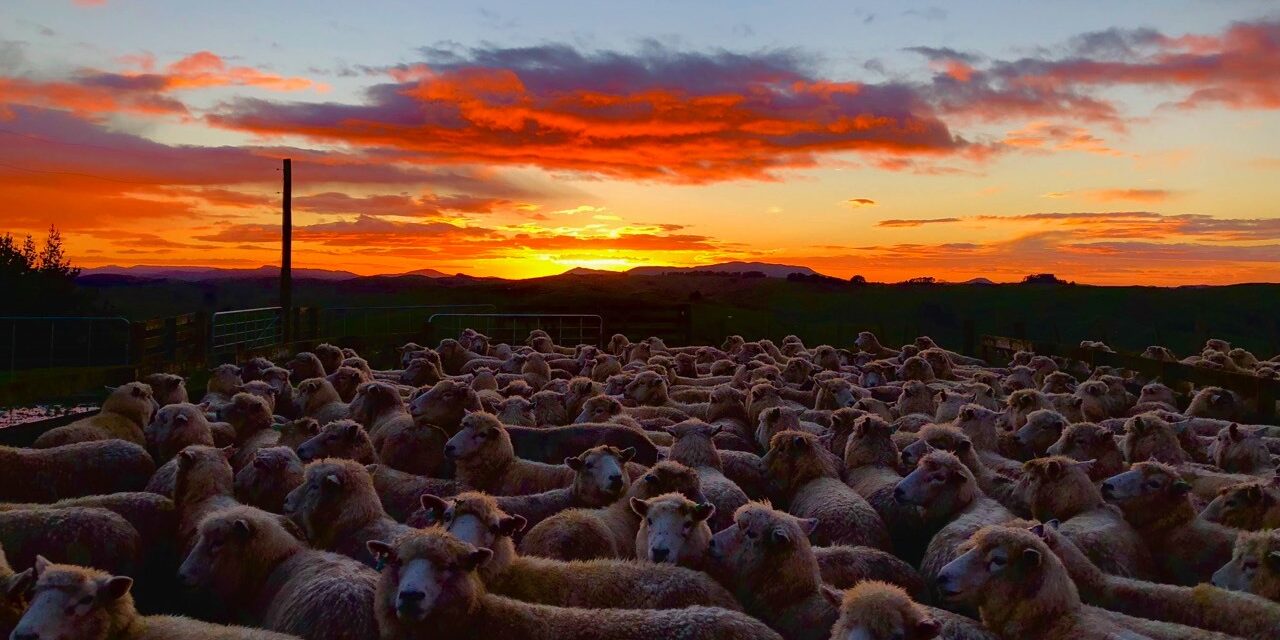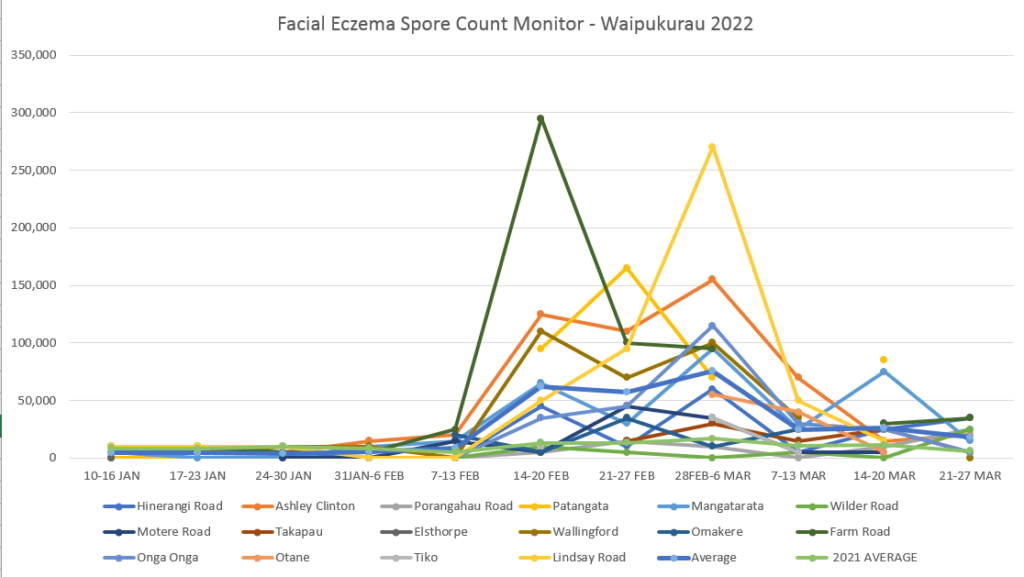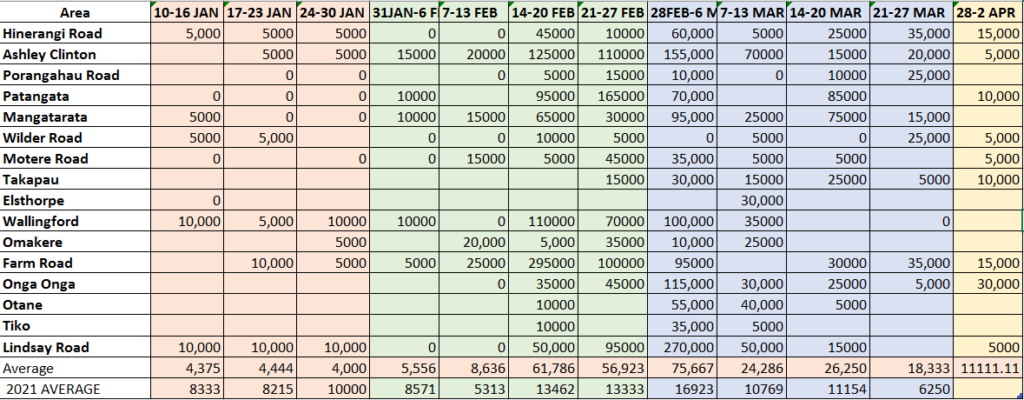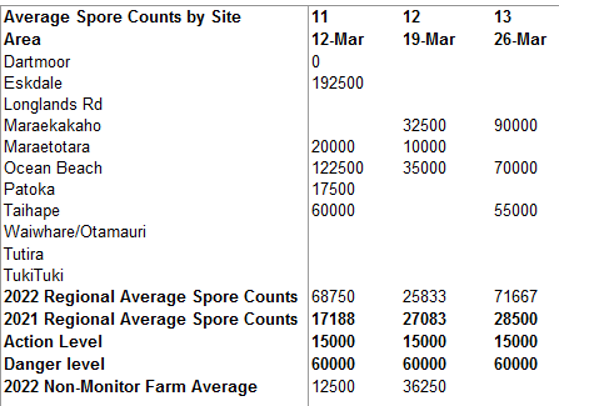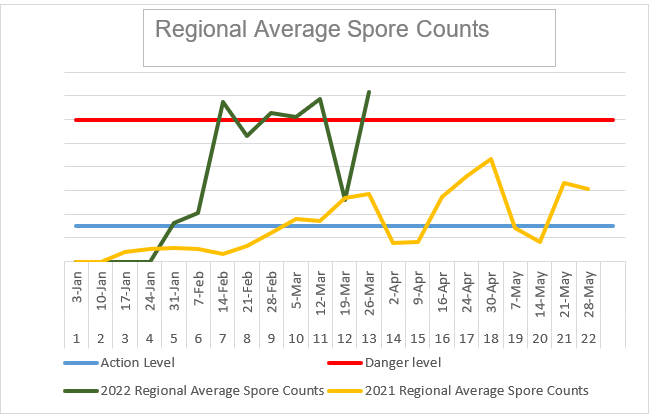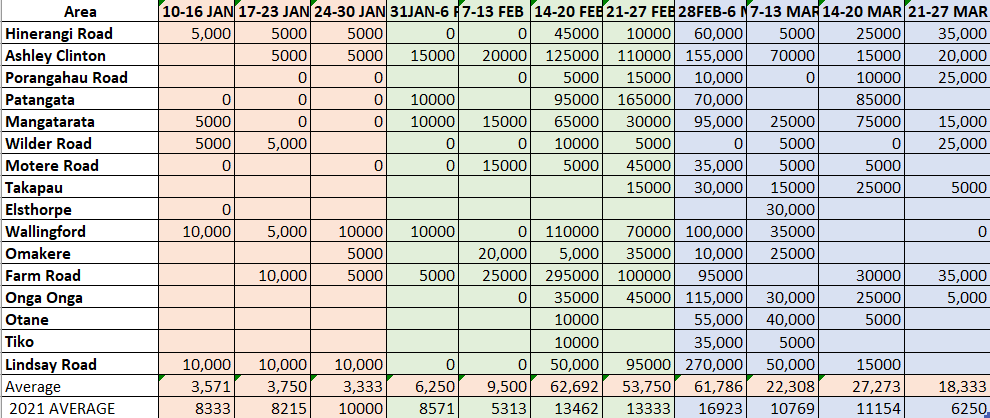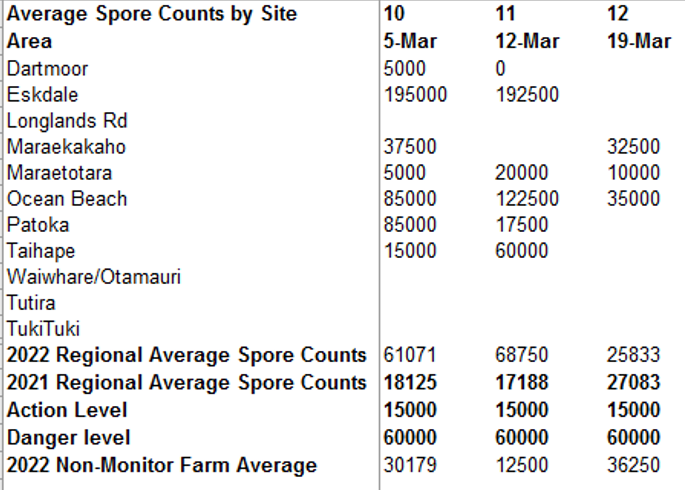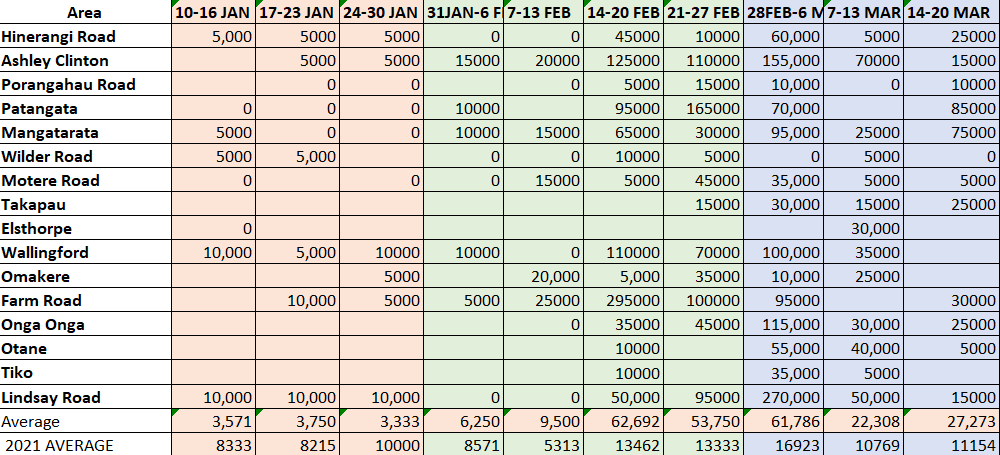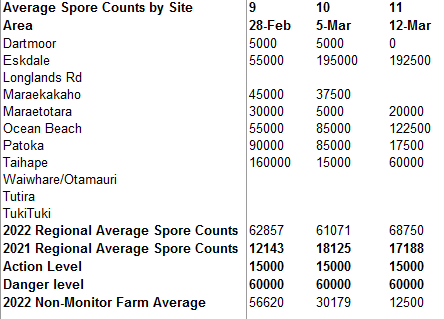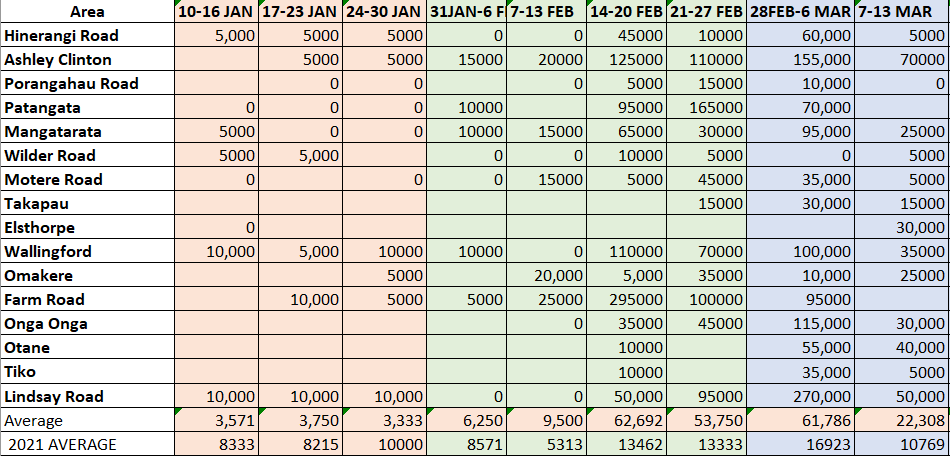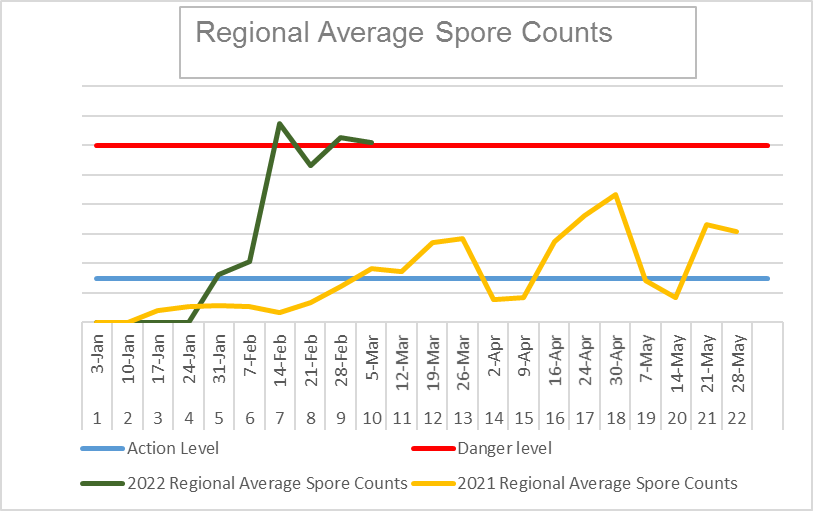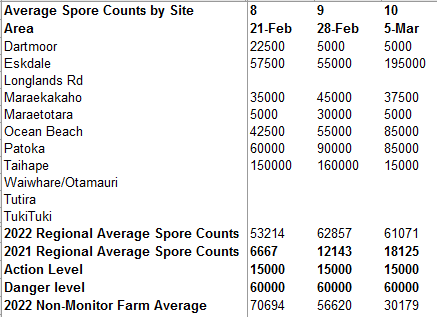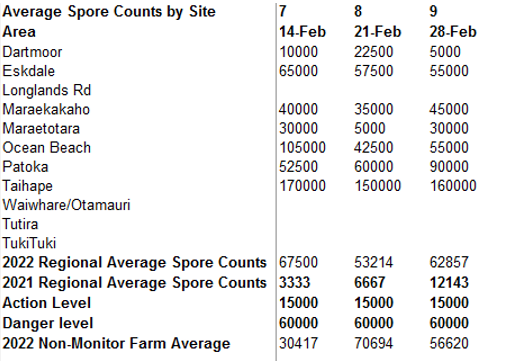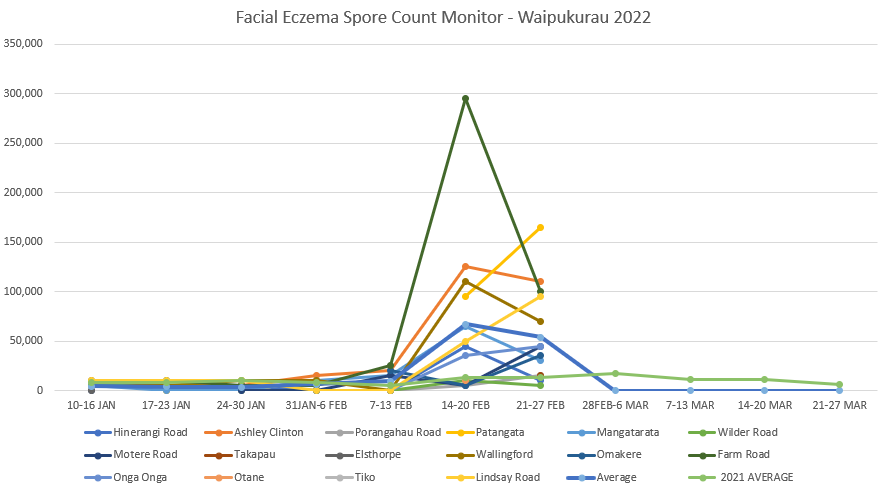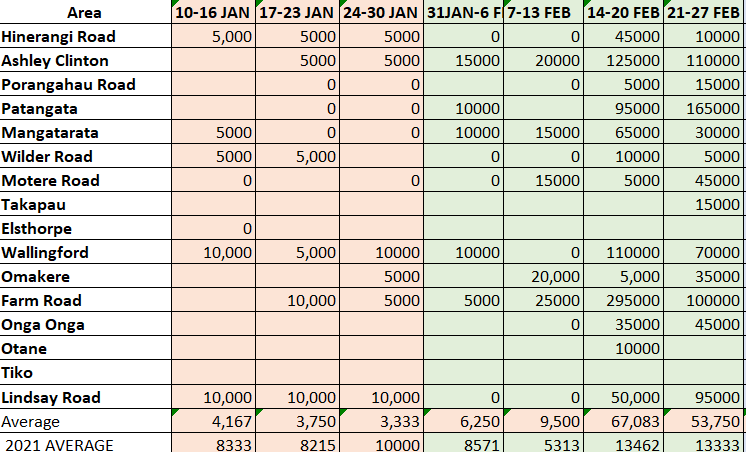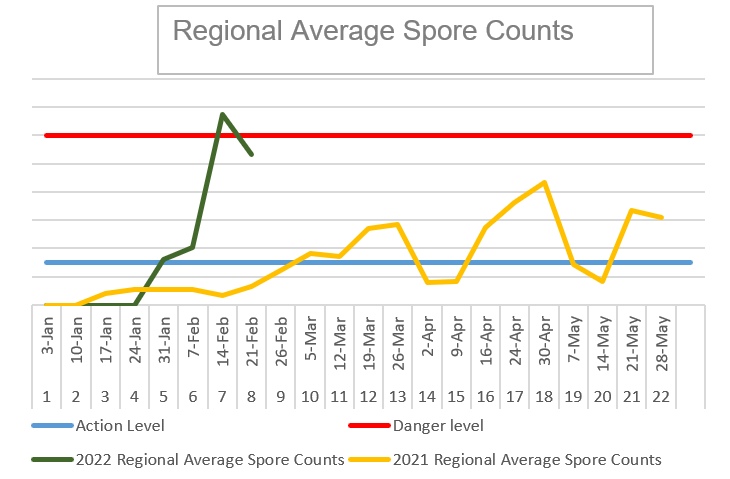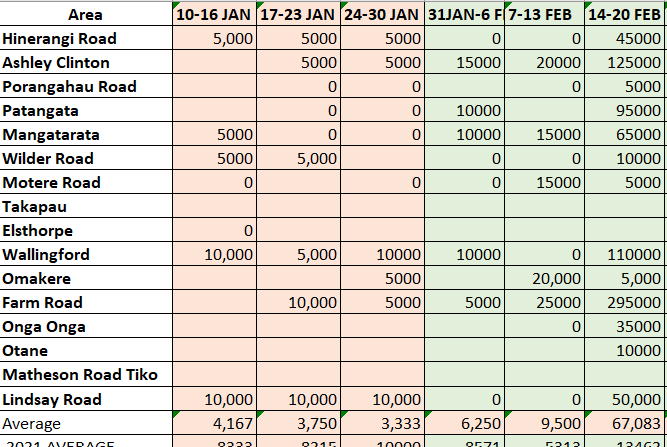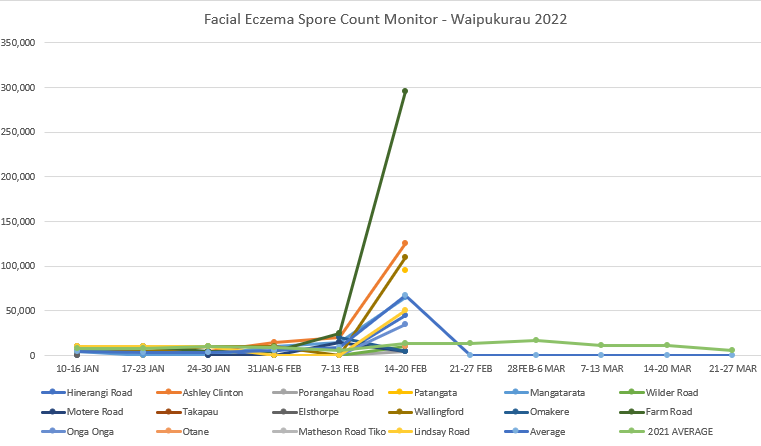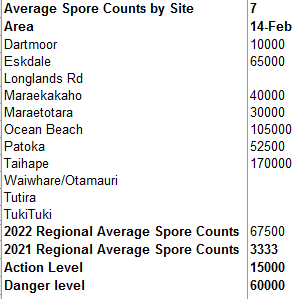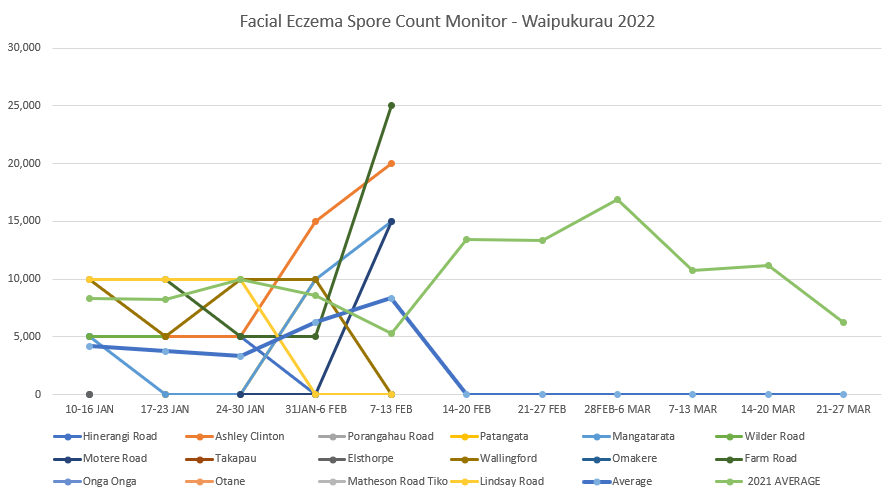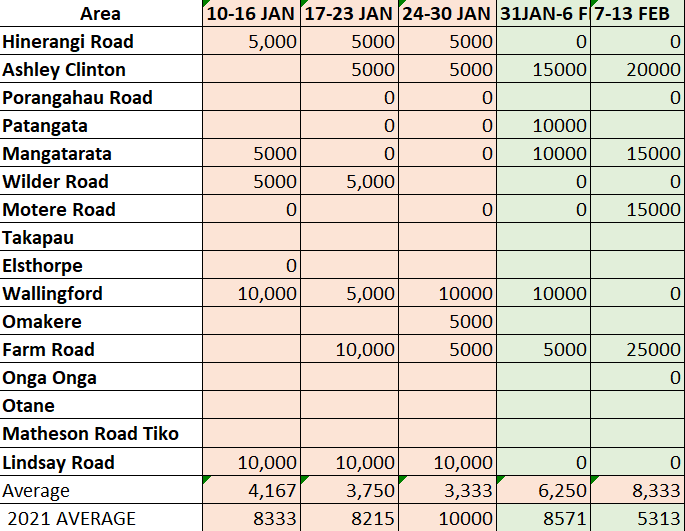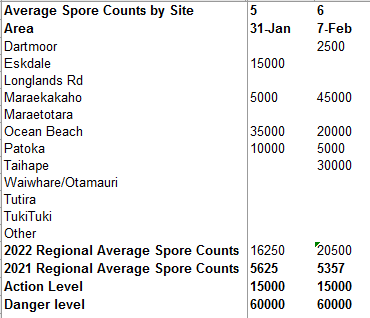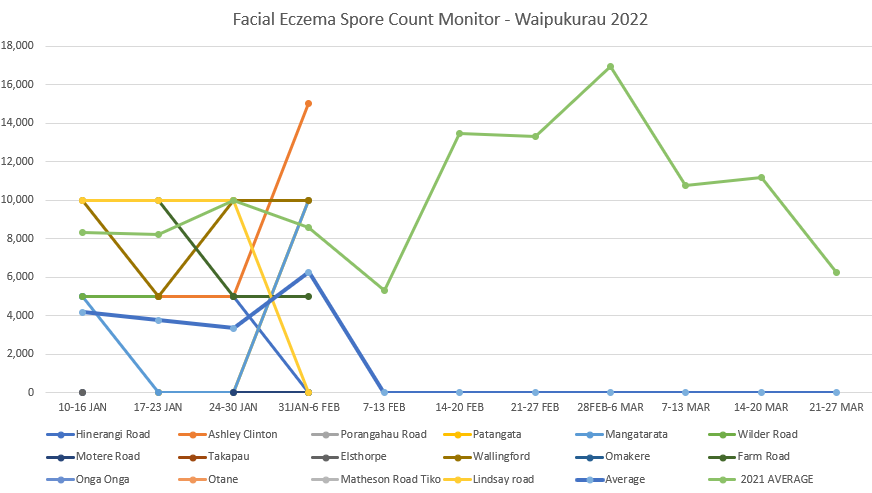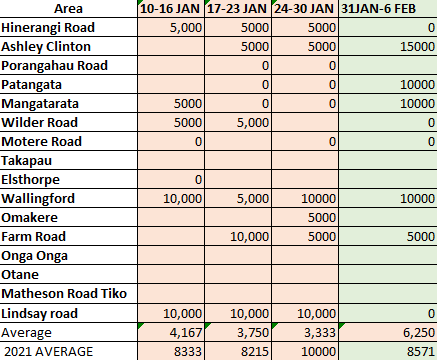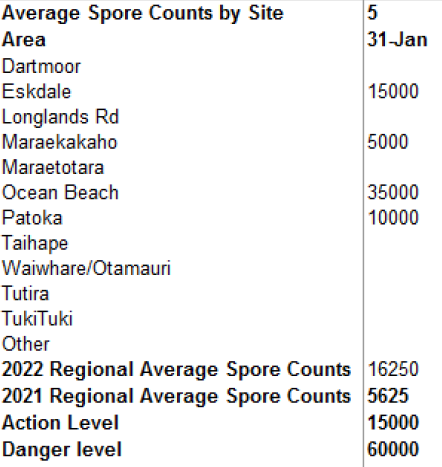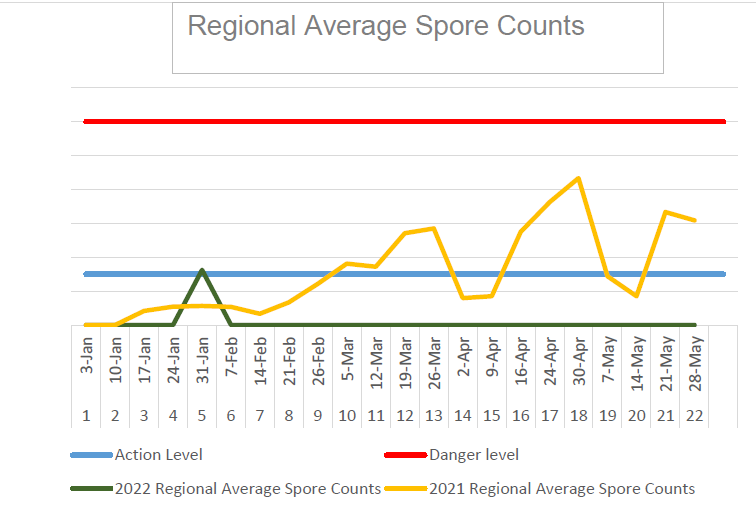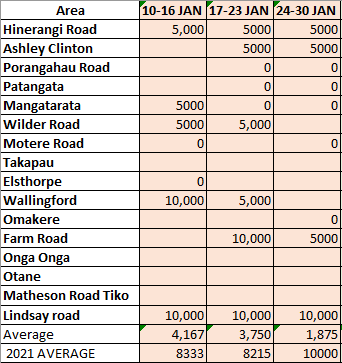Facial Eczema Pasture Spore Counting
1 April 2022
WAIPUKURAU
HASTINGS
Spore counts for this part of Hawke’s Bay have increased this week and are on average at a dangerous level of 71 000 spores per gram of pasture. With many farmers busy fixing fences and clearing slips after mammoth downpours, the number of samples we have received has again been few and far in between and we recommend bringing in a sample of your own pasture to accurately assess your risk. This week’s hotspots included a 110 000 spores per gram of pasture at Ocean Beach and 70 000 along the Napier-Taihape Road.
Trend graph of 2022 Regional Average Spore Counts compared with last year’s data.
Clinical cases of facial eczema continue to pop up and the benefit of preventative treatment far outweighs the cost of preventative treatment and potential production losses.
It is important to keep monitoring the spore counts. The rain may wash away some of the spores, but mild overnight temperatures and humid conditions will allow fungi to grow and sporulate quickly. The risk period runs into May and can change quickly.
Option to mitigate your risk include:
- Identifying high and low risk areas on your place by spore counting
- Prioritising most at risk stock (replacements ewe lambs/heifer calves) on the safest pastures
- Avoid grazing to low residuals
- Zinc treatments – boluses, zinc oxide, zinc trough/water treatments (cattle)
- Reducing spore loading by supplementary feeding
- Spraying selected paddocks with a fungicide (talk to us about paddock selection criteria)
- Sell saleable stock
25 March 2022
WAIPUKURAU
HASTINGS
We continue to see some clinical cases of facial eczema. Clinical signs usually show up 10 – 14 days after the ingestion of a toxic dose of spores.
With much of the region soaked to the bone presently, spore counts are expected to remain in the low to moderate region, but it is important to keep monitoring the spore counts especially as the skies clear and mild nights continue. The risk period runs well into May and can change quickly. For a more accurate risk assessment, best advice is to monitor the spore counts on your pastures.
Regular monitoring and reviewing your action plan is key. Please get your orders for preventative facial eczema treatment in as early as you can to avoid potential supply chain delays.
18 March 2022
WAIPUKURAU
A general trend downward this week with a definite change in overnight temperatures. Occasional hot spots but the numbers of these are reducing. We will continue to monitor whilst there is still a risk.
Clinical cases may be arising in areas that have been affected within the last few weeks – be on the lookout for these and act promptly if you are suspicious. Look for animals seeking shade or heads down and droopy ears and seek advice if you need to.
HASTINGS
Spore counts continue to be high with a weekly average of 68,750 for this part of the Hawke’s Bay region. However we are seeing values at either end of the spectrum. We are still seeing a few hot spots this week especially in Eskdale with counts of 275,000spg and 110,000spg and Ocean Beach with counts of 215,000spg. Only one non-monitor farm brought in samples this week, and they were low so this may not be reflective of what is actually happening.
The counts seem to be slowing down which the cooler nights may be helping but continual spore count monitoring is needed and animals of high risk need treatment.
11 MARCH 2022
WAIPUKURAU
Spore counts are again trending down this week with occasional hot spots and some clinical cases filtering through where there has not been any preventative programme in place.
Remain vigilant checking animals for any signs if there has not been any prevention, as hot spots in some areas may still cause problems. As the cool nights continue we expect spore counts to slowly drop.
HASTINGS
11 March 2022
Spore counts for this week have continued to trend dangerously high for this part of the Hawke’s Bay region. On average our monitor farms were at 61 000 spores per gram of grass, while non-monitor farms have declined to an average of 30 000 spores per gram of grass. The range was quite large with a few paddocks at zero, to a staggering 275 000 spores per gram of grass in Eskdale. Other hotspots included a 100 000 at Ocean Beach, 95 000 in Crownthorpe and 85 000 in Patoka. Spore counts continue to trend much higher compared this time last year when it was still very dry and dusty and average spore counts were at 18 000 spores per gram of grass.
The large variation in spore counts and widespread hotspots across the region highlights the importance of doing your own spore counts. Overnight minimum grass temperatures have been mild this week and a heavy dew glistening in the morning sun is a good indication of the high moisture levels in pasture, providing a great environment for fungal growth. With more moisture expected to arrive next week and night time temperatures remaining mild, it is likely spore counts will remain high. We continue to see the odd sporadic case of clinical facial eczema, where stock was used to clean out pasture.
Options to consider include:
- Identifying high and low areas on your property by spore counting
- Prioritising most at risk stock (replacements ewe lambs/heifer calves) on the safest pastures
- Avoid grazing to low residuals
- Zinc treatments – boluses, zinc oxide, zinc trough/water treatments (cattle)
- Spraying selected paddocks with a fungicide (talk to us about paddock selection criteria)
If you’re putting the ram out in the next few weeks, consider treating rams and ewes with zinc capsules to protect sheep in case spore counts rise during the mating period, this will help prevent poor scanning performance and the catastrophe of clinical facial eczema in your flock. It doesn’t take much of a drop in lamb production to justify the $4.83 including GST investment to protect a ewe during a critical time of the production cycle. Please get your orders for preventative facial eczema treatment in as early as you can to avoid potential supply chain delays.
4 March 2022
Spore counts are still very high for this part of Hawke’s Bay with the average for our monitor farms at 62,857 and for our non-monitor farms at 56,620. This week’s hotspots for monitor farms have seen counts rise again at Napier-Taihape Road to 220,000 spg. Spore counts also rose in Patoka to 140,000 and Ocean Beach to 90,000. Our non-monitor farms hotspots were seen at Raukawa with spore counts rising to 220,000; Clive at 90,000 and Waiwhare at 80,000.
This week’s weather brought some much needed cooler nights, the odd bit of rain and there is a twinge of autumn in the air. Spore counts are unfortunately still dangerously high and the cooler nights have not been cool enough yet to bring the average spore count down.
If you would like to bring grass samples in to be tested, here are a few pointers:
- Collect samples from paddocks you know are higher risk historically or paddocks that you may wish to graze next in rotation
- Collect a handful of grass which the stock are most likely to graze, from approximately 10 random sites in the paddock.
- The total amount of grass required is approximately 1 bread bag full.
- Cut or pluck the grass 0.5cm above ground level.
- Avoid getting dirt in the sample.
- Place in a paper bag or wrap in newspaper
- Deliver to the clinic in the morning and results will usually be available later the same day.
If you’re putting the ram out in the next few weeks, consider treating rams and ewes with zinc capsules to protect sheep in case spore counts rise during the mating period, this will help prevent poor scanning performance and the catastrophe of clinical facial eczema in your flock. It doesn’t take much of a drop in lamb production to justify the $4.83 including GST investment to protect a ewe during a critical time of the production cycle. Please get your orders for preventative facial eczema treatment in as early as you can to avoid potential supply chain delays.
23 FEBRUARY 2022
(WEEK 7)
WAIPUKURAU
The average count for the region has dropped this week but some areas have increased. Most are still within the danger zone and prevention strategies should be in place. With limited options available for treatment once animals become clinical, prevention is by far the best option.
HASTINGS
Spore counts for the Hawke’s Bay region remain high this week and are dangerously high compared to this time last year when counts were still very low. The average spore count for our monitor farms has slightly dropped from 67,500 to 53,000 spores per gram (spg), however that still has alarm bells ringing. This week’s hot spots for one off counts on our monitor farms include 150,000 at Napier-Taihape Road, 90,000 at Patoka, 75,000 at Eskdale and 70,000 at Ocean Beach Road. Basically, levels are high in many areas across the region.
To reinforce this point, our non-monitor farms produced an average of 70,000 spg. Several hot spots were well above 100,000 spg. Middle road is consistently producing high spore counts at an average of 80,000 and Raukawa/Valley Road has also seen very high counts. Being above the ‘danger level’ of 60 000 spg, the odd clinical case of facial eczema is rearing its head, and unfortunately we expect more will be seen. Please keep vigilant around managing these cases.
Trend graph of 2022 Regional Average Spore Counts compared with last year’s data.
__________________________________________________________________________________________________________________________________
18 FEBRUARY, 2022
(WEEK 6)
Spore counts for the Hawke’s Bay region have sharply increased this week and are dangerously high compared to this time last year when counts were still very low. The average spore count for our monitor farms is at the dangerously high level of 67 500 spores per gram of grass.
This week’s hot spots for our monitor farms include an astonishingly high 295000 spores per gram of grass on Farm Road, 270 000 on the Napier-Taihape Road, 170 000 in Ocean Beach, 125 000 in Ashley Clinton, 110 000 in Wallingford and 100 000 in Maraekakaho. The average spore counts for non-monitor farms was 30 000 with a hot spot of 145 000 spores per gram of grass in the Waiwhare area and 50 000 in Kereru and Puketitiri. On average we are above the ‘danger level’ of 60 000 spores per gram of grass and the odd clinical case of facial eczema has already been seen.
Although the region is slightly greener after the recent rain, there is plenty of dead matter around providing a lovely warm, humid environment for spores to sporulate and we are expecting the spore counts to continue rising in the next week.
If you’re putting the ram out in the next few weeks, consider treating rams and ewes with zinc capsules to protect sheep in case spore counts rise during the mating period, this will help prevent poor scanning performance and the catastrophe of clinical facial eczema in your flock. It doesn’t take much of a drop in lamb production to justify the $4.83 including GST investment to protect a ewe during a critical time of the production cycle. Please get your orders for preventative facial eczema treatment in as early as you can to avoid potential supply chain delays.
WAIPUKURAU
HASTINGS
____________________________________________________________________________________________________________________
WEEK 5
Waipukurau
Spore counts have decreased with the heavy rain over the weekend but occasional properties with samples collected once the rain had stopped showed an increase. It is likely if we see warm weather after the wet there will be an increase in spore counts. Consider having a prevention plan in place that can be actioned once trigger levels in your area are reached.
Hastings
Spore counts in the Hawke’s Bay region are rising and on average at 20 500 spores per gram of grass this week, up from 16 250 last week, and above the ‘Take Action’ level. Compared to this time last year when counts were holding steady around the 5000 spores per gram of grass, the spore counts are significantly higher. This week we saw a hot spot in Maraekakaho area at dangerous 70 000 and high of 40 000 along the Napier-Taihape road.
The region has had a good soaking the last week with some areas getting well over a 100mm over a few days. Although restless night due to summer drought worries is less this year, the warm muggy night temperatures this week is certainly causing some restless nights. Unfortunately, the fungus, Pithomyces chartarum, which produces the toxic facial eczema spores, loves warm muggy nights and with more rain expected, the high humidity will continue to provide a favourable environment for the fungus to grow and produce spores.
With spore counts this rising, we would like to remind farmers to be proactive in preventative measures and to take action early to protect stock and potential production losses. If you’re putting the ram out in the next few weeks, consider treating rams and ewes with zinc capsules to protect sheep in case spore counts rise during the mating period, this will help prevent poor scanning performance. Please get your orders for preventative facial eczema treatment in as early as you can to avoid potential supply chain delays.
__________________________________________________________________________________________________________________________________________
WEEK 4
Waipukurau – Slow but steady increase in spore counts this week. Keep an eye on the weather over the next few weeks and if we get the promised rain followed by some warm spells we may see a lift in spores.
Hastings – For this region, the spore counts have jumped from low the last few weeks, to an average of 16 250 spores per gram of grass this week and we are already over the action level of 15 000. The average this week is higher than it was this time last year and Ocean Beach area had a hot spot with a high count of 55 000 spores per gram of pasture.
.
Trend graph of 2022 Regional Average Spore Counts compared with last year’s data
__________________________________________________________________________________________________________________________________________________________________
WEEK 3
Hastings
Our spore count monitoring has started and so far average values are low but spores are starting to pop up in some areas. Keep an eye on the monitor farms and consider taking samples from high risk paddocks if you are concerned.



